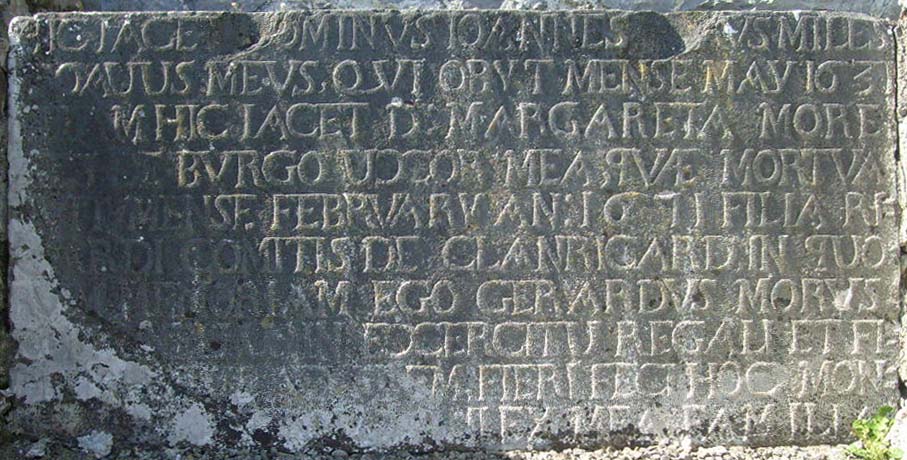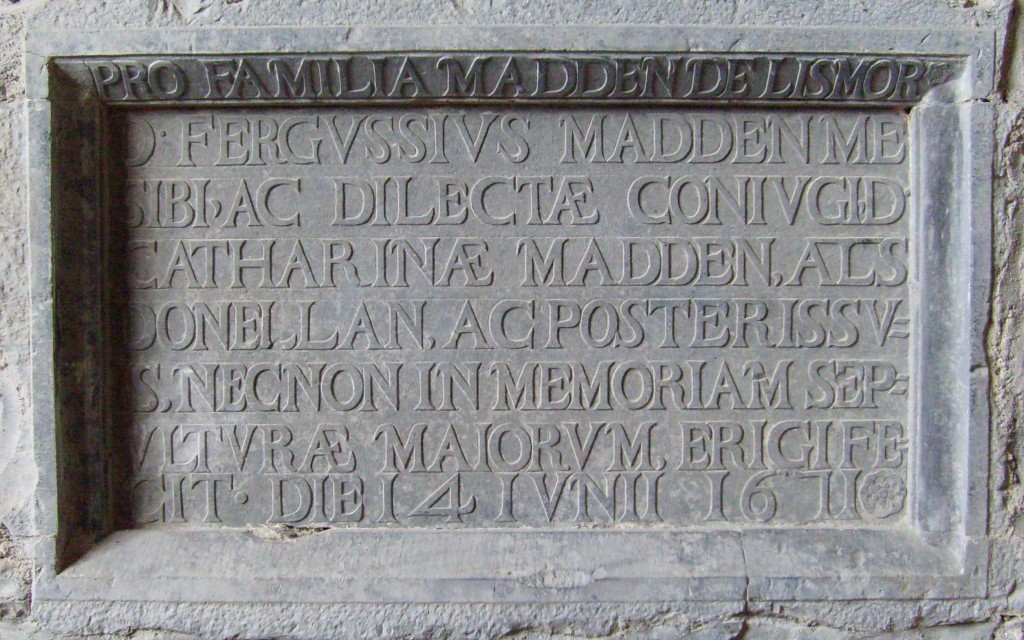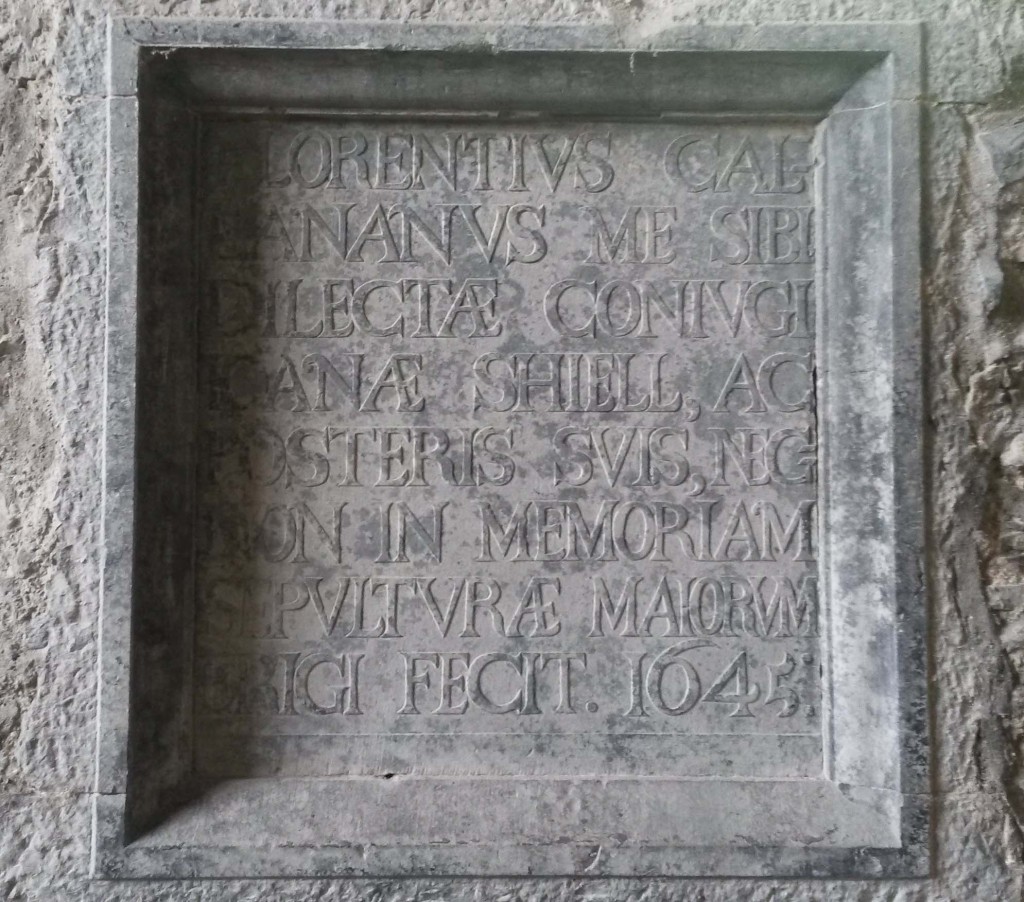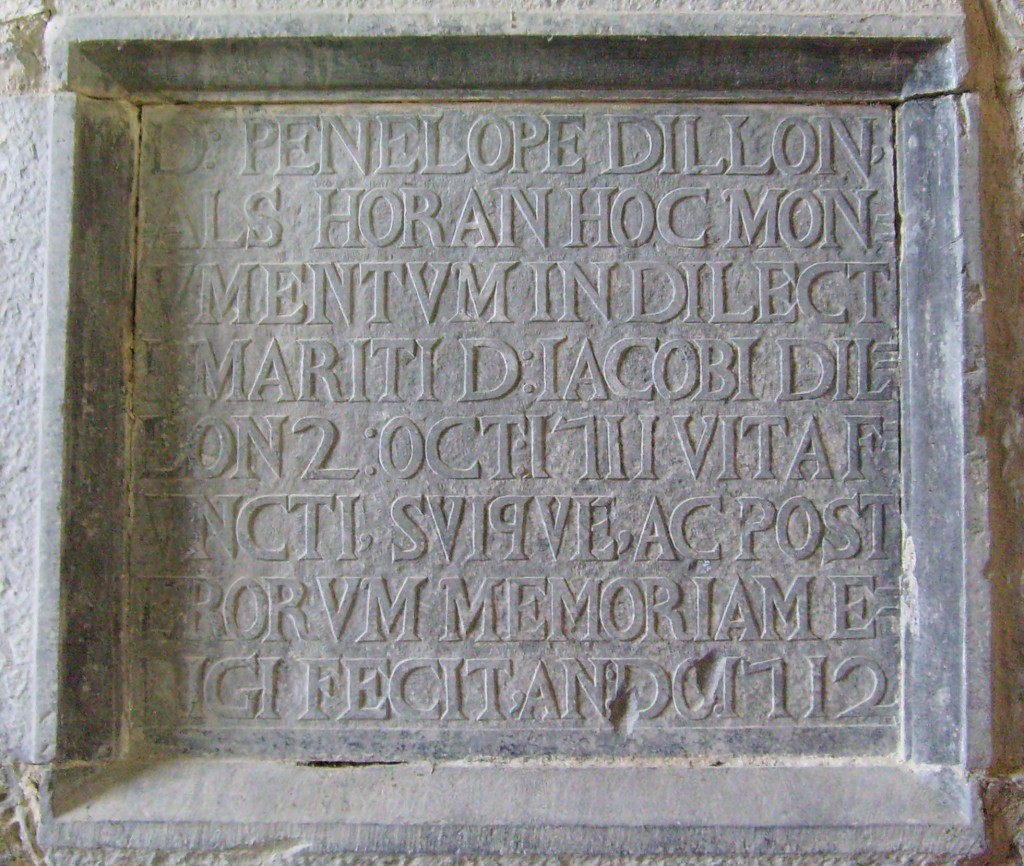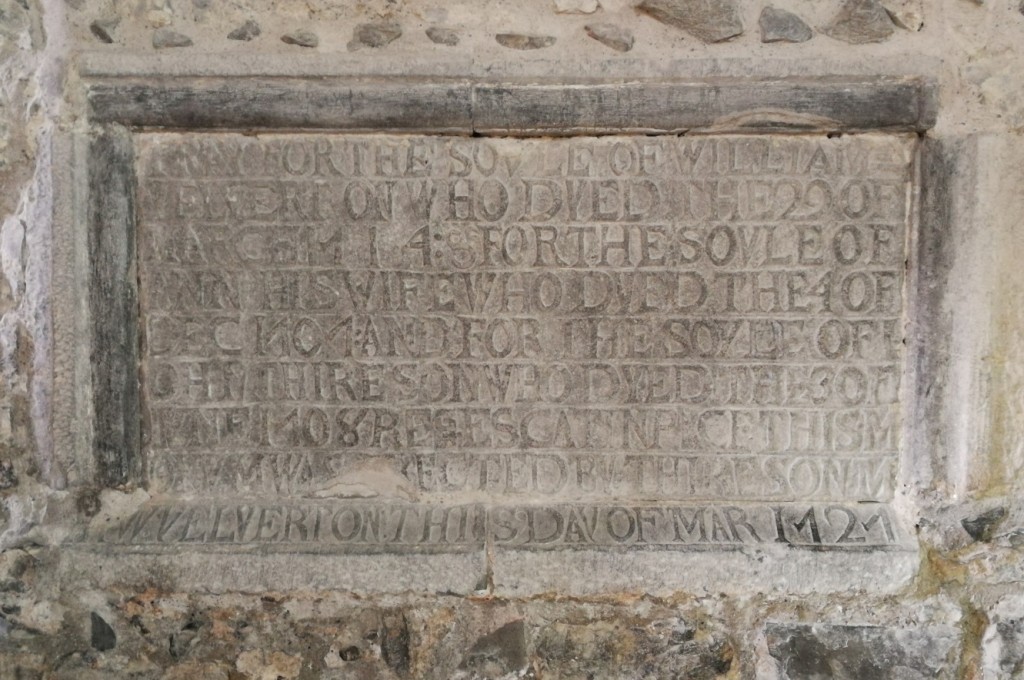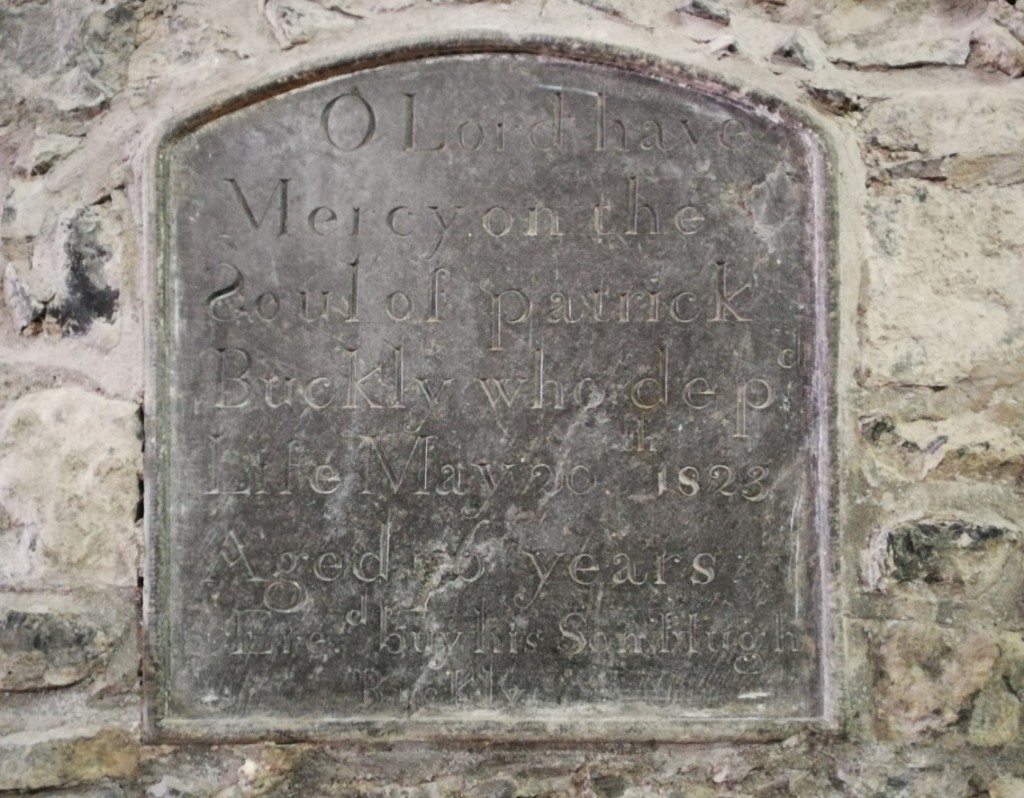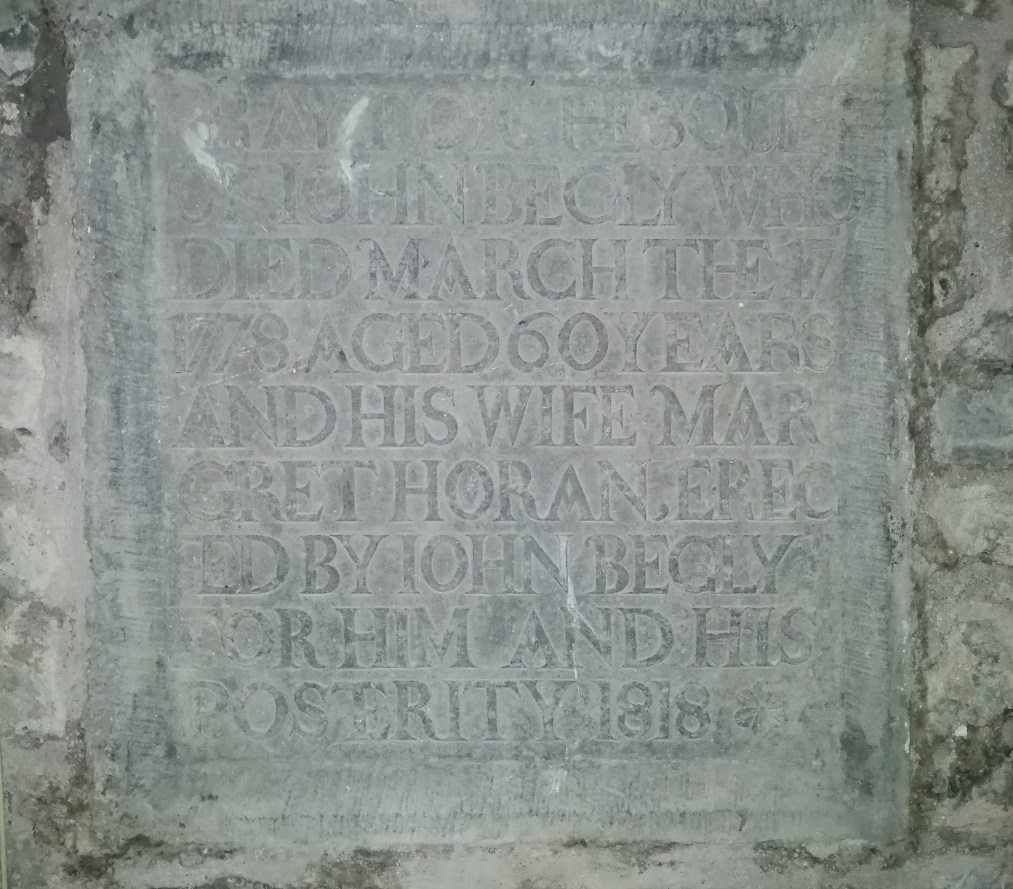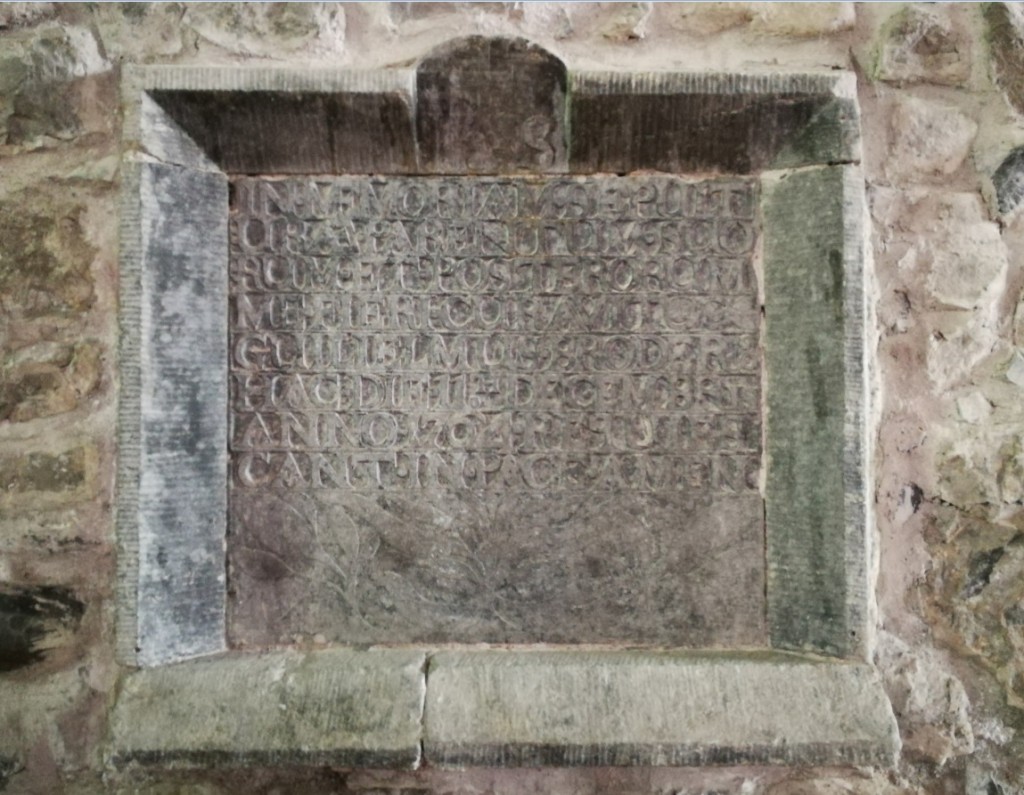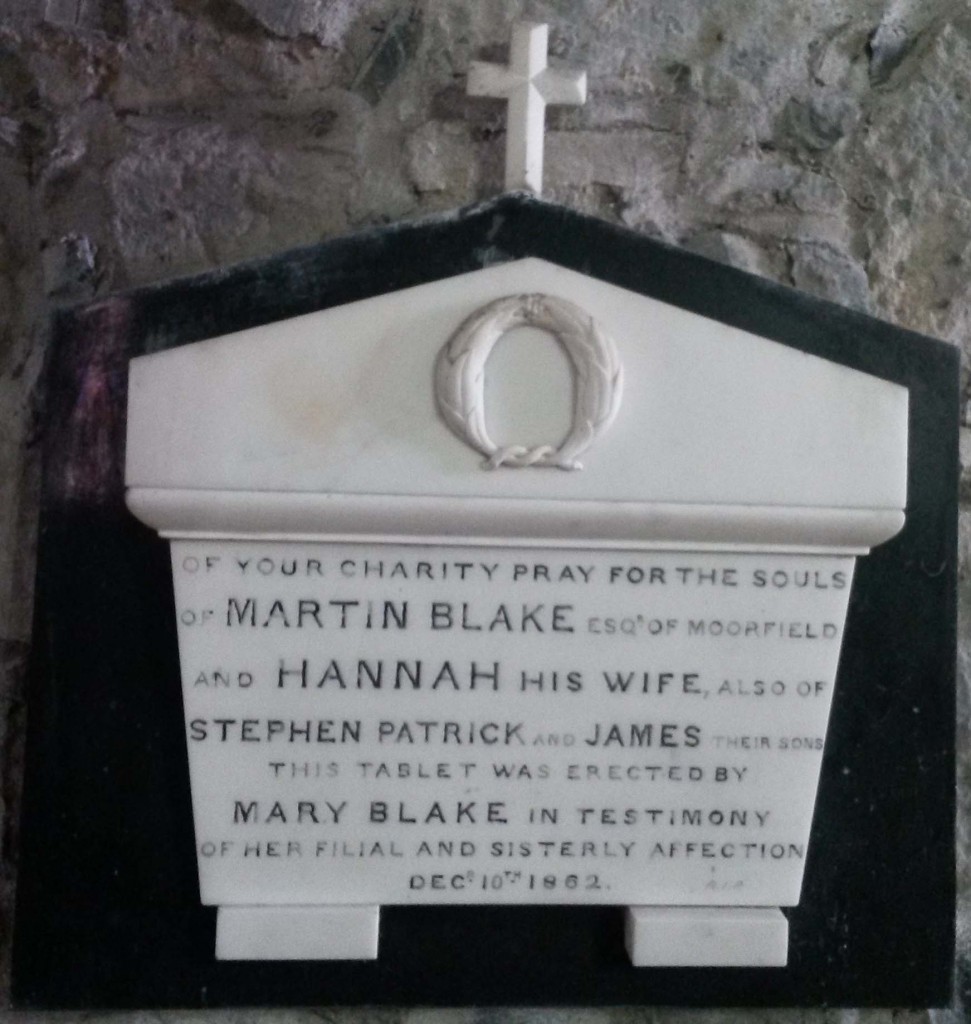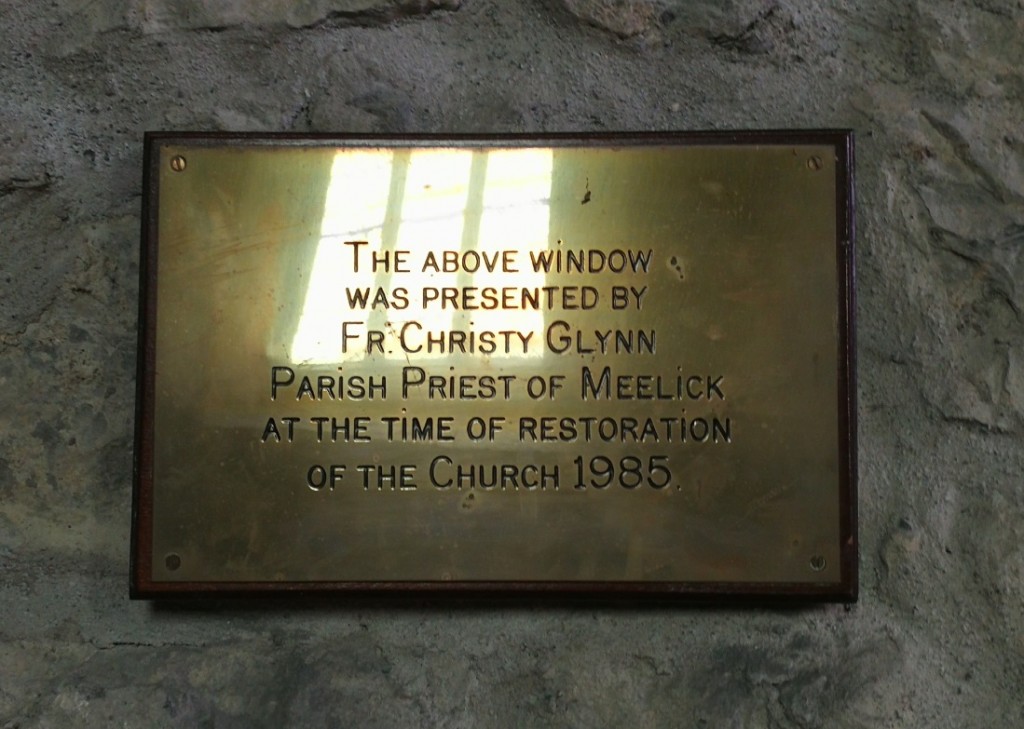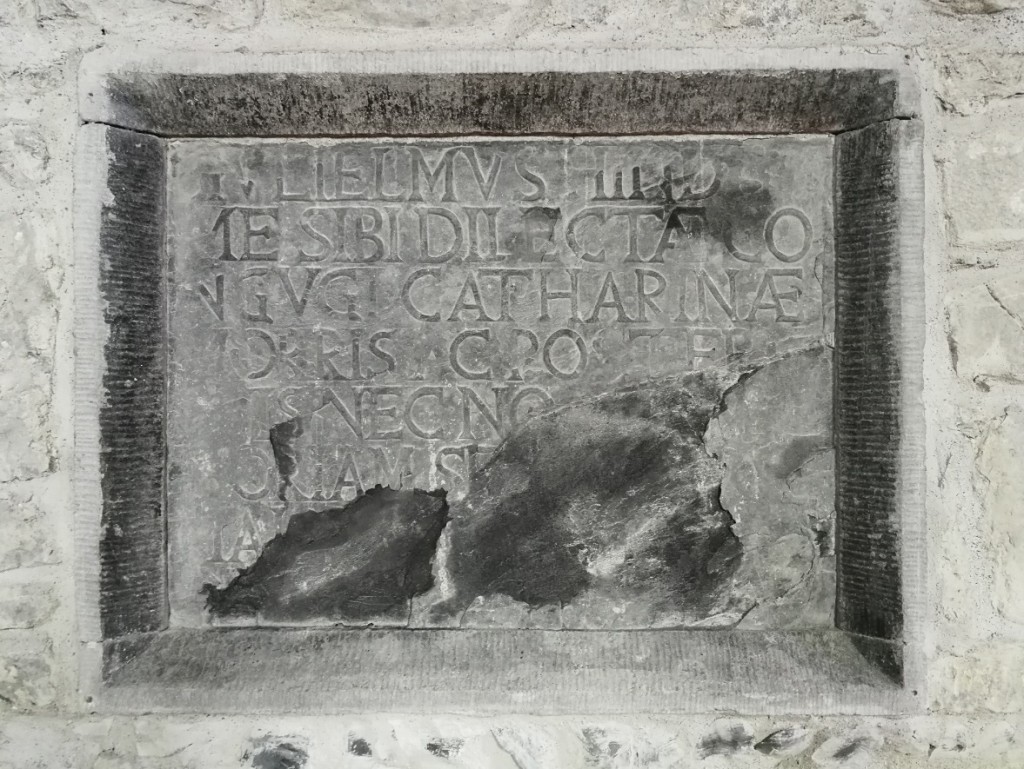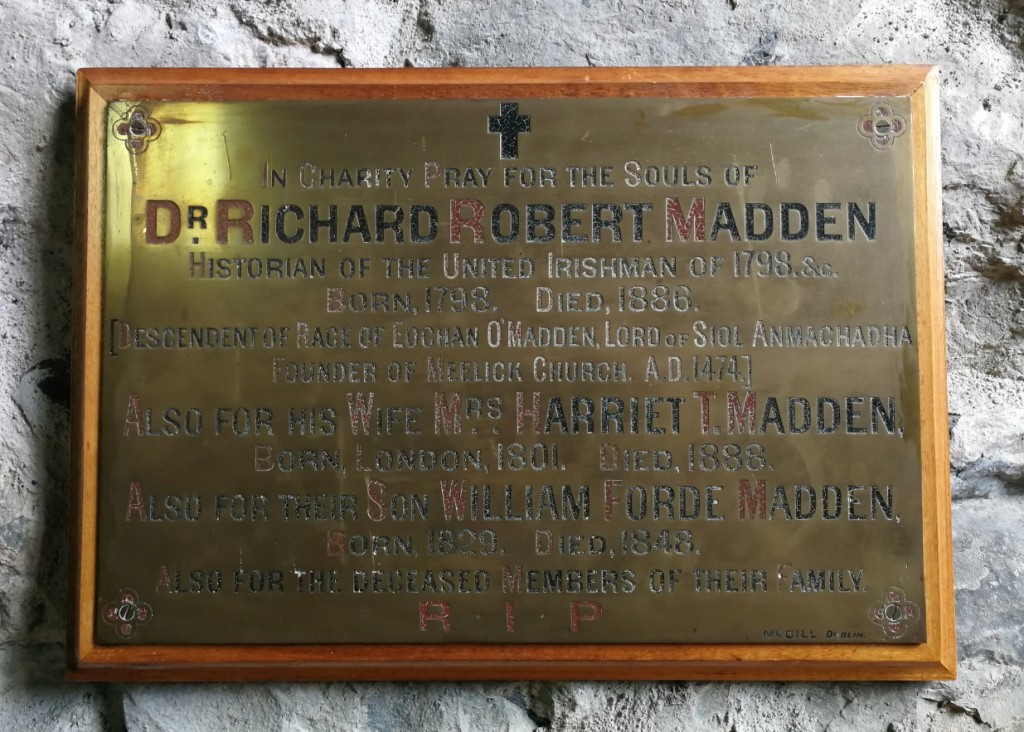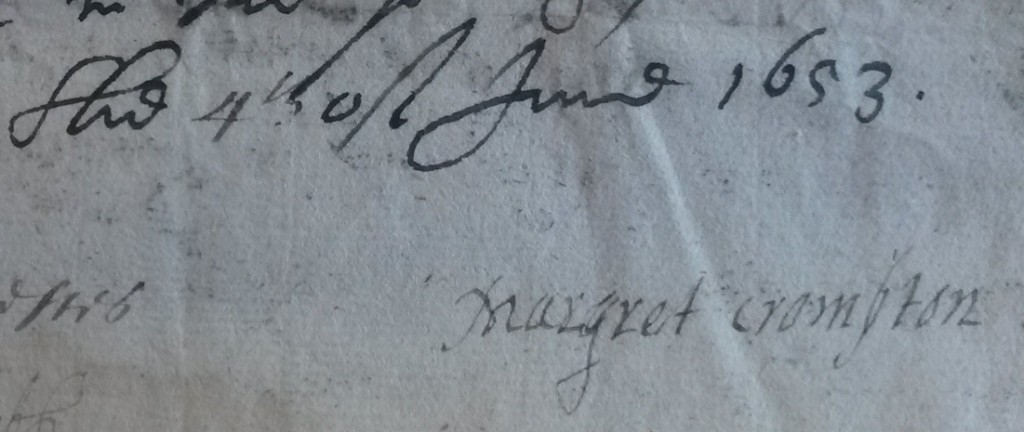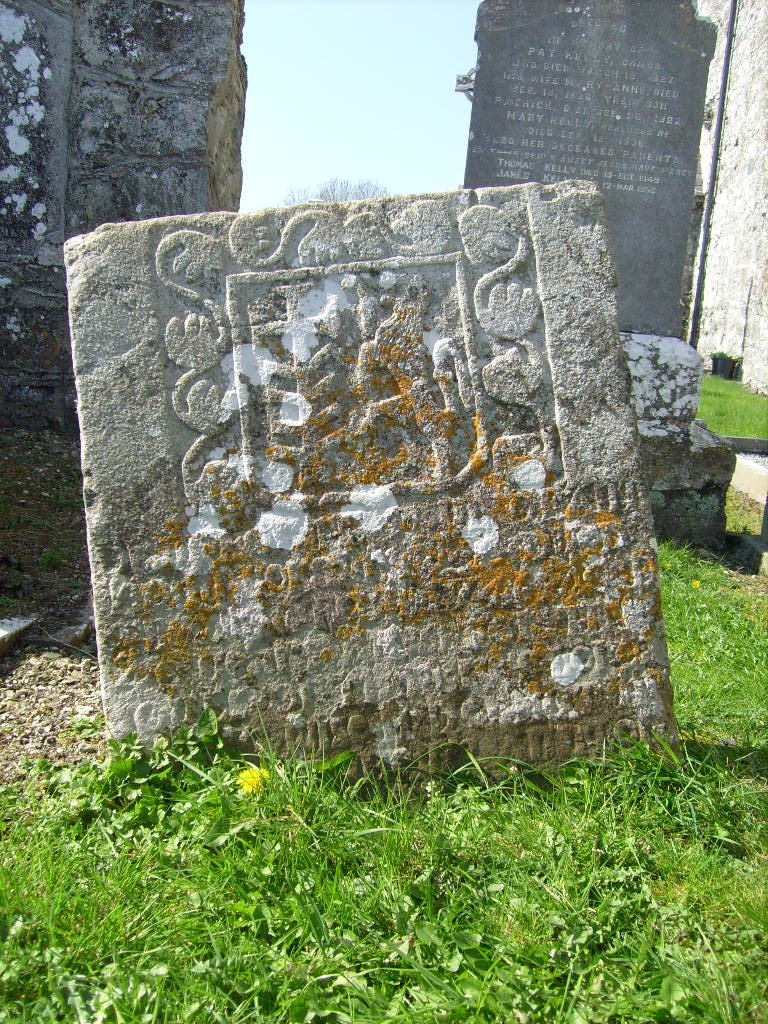I
Existing memorials and tablets within church and ruins of side chapels
This stone, in Latin, at the base of the East gable of the friary church, reads ‘Here lies Dominus Joannes Morus, ‘miles’, my grandfather, who died in the month of May 1631. Also here lies D. Margareta More alias de Burgo, my wife, who died in the month of February 1671, daughter of Ricardi Comitis de Clanricardini, in whose memory, I, Gerardus Morus, Colonel in the army of the King and faithful to the last, have caused to be constructed the tomb in which others of my family are also interred.’
This stone marks the burial vault of the Moore family of Cloghan, which was located on the right hand side of the high altar of the friary church (as viewed from the aisle). With the collapse over time of the east gable wall, and its reconstruction at a later date further to the west, the burial vault was thereby located outside of the new gable wall and the church proper.
A corresponding memorial was also inscribed to Colonel Garrett Moore’s grandmother Lady Mary Burke, (ie. wife of John More or Moore) at the family tomb in the Mayo abbey of St. Marys, Ballinasmale, John Moore having acquired the nearby Ball and Brize estates of the Prendergasts about 1607. The inscription reads ‘Sub hoc lapide Dna. Maria More alias Burke filia Ricardi Sasenach Comitis Clanrickard quae dcessit 1624 cum tribus ejus filiis Joanne Geraldo et Jacabo per Joannem More Armigerum aliisque multis ex ipsa ortis. In cujus memoriam hoc erigi fecit Giraldus More Collus et C.’ ‘ Catlicus lector enixe rogatur pro ipsi orare.’ (J.R.S.A.I. 1901, Vol. XXXI)
For further details refer to ‘Moore of Cloghan’ under ‘Families’.
Located on the south wall of the church in the late-twentieth century, a finely carved stone tablet reads, ‘Pro familia Madden de Lismor, D. Fergussius Madden me sibi, ac dilectae conivgi, D. Catharinae Madden, als Donnellan, ac posterissus, necnon in memoriam sepulturea maiorum, erigi fecit, die 14 Iunii 1671.’
Fergus Madden of Lismore was described by the Meelick friars at the time of his death as a man ‘full of years and of riches, of good wit and education, a special friend and benefactor’ of the friary. A significant landholder in the late seventeenth century, he died of a fall from his horse and after receiving sacramental absolution on 7th September 1687. He was buried ‘near the wall under his monument’ in the church at Meelick’. Refer to ‘Families’ for further details regarding the families of ‘Madden of Lismore’ and ‘Burke of Lismore’’. Various Madden families, other than those of Lismore, having a separate and distinct descent from those of Lismore, were also interred at Meelick.
Florence Callanan and his wife were commemorated on a stone slab erected at Meelick during the Rebellion; ‘Florentius Callananus me sibi Dilectae Conivgi Joanae Shiell, ac posteris suis, negnon in memoriam Sepulturae maioruim erigi fecit 1645.’
For further details on ‘Callanan’ under ‘Families’.
Stone plaque reads ‘D. Penelope Dillon, als. Horan hoc monumentum in dilectae mariti D: Jacobi Dillon 2: Oct 1711 vita functii, suique, ac posterorum memoriam erigi fecit an:do: 1712.’
Mr. James Dillon of Rath was among those friends of the friars to whom ‘ornaments spirituall and temporall belonging to the convent of Milicke’ were entrusted in 1698 as a consequence of the ‘Banishment of Religious Act’. Given into his care were ‘one entire vestiment, a mass booke and two chalices, one gilt with gold with this inscription: Ad usum Fratris Francisi Madden qui me fieri fecit pro conventu de Milicke anno Domini 1638. The other not gilt hath this inscription: Frater Jacobus Coghlan me procuravit pro conventu de Milick anno Domini 1616.’
Refer to ‘Horan of Fahy’ under ‘Families’ for details of this family and the location of the Horan burial place within the church.
A stone plaque erected in 1727 by Matthew Yelverton, which reads ‘Pray for the sovle of William Yelverton who dyed the 29 of March 1714: for the sovle of Ann his wife who dyed the 4 of Dec 1707 and for the sovle of John thire son who dyed the 30 __ 1708 Reqescat in pace This m__vm was _rected by thire son M_w Yelverton: This day of Mar 1727′.
The Meelick Obituary recorded the death of Anne Yelverton on 4th December 1707 and her burial two days later in the church of Meelick. Domicialla, daughter of Matthew and Elizabeth Yelverton of Portland, died in January 1766 and three years later Matthew’s wife Elizabeth died and was buried in the Yelverton family tomb in Meelick. On the last day of that same year Matthew Yelverton died and was buried beside his wife. The obituary later recorded the death in 1787 of George Yelverton of Bellisle. He likewise was buried in the family tomb. (Journal of the Association for the Preservation of the Memorials of the Dead in Ireland, Vol. VI, Part I, 1904-1905-1906, Ponsonby & Gibbs, Dublin, 1906, pp. 79-84.) Refer to ‘Part II’ of this article for detail of a now missing slab once situated below which related to the granddaughter of George Yelverton of Bellisle.
A small modern brass plate fixed to the south wall, commemorating the death in 1893 of a member of a Kelly family, Keelogue, Meelick.
Pray for the soul of Nicholas Skerret who died the year 17– Jane Fallon his wife also died the year 1747 James Skerret their son who died 1755 Jane Lench his wife and their posterity.’
The Meelick friars, in recording the death of James Skerrett of Eyrecourt on the 14th September 1755 described him as a merchant and a benefactor of the friary and that, having ‘fallen asleep piously in the Lord’ was buried in the church at Meelick. See ‘Part II’ of this article for more detail on this slab and for a now missing slab once situated below. ‘This 11th June (1667) died Master Nicholaus Skiret a benefactor of this convent. May he rest in peace.’ (Papers relating to Meelick friary 1644-1731’ Collectanea Hibernica Vol. 16 pp 50-88) The Ordnance Survey letters relating to the parish of Meelick in 1838 refer to a stone bearing the name of Nicholas Skerret. James and Patrick M. Skerrett were among the gentry of Eyrecourt in Slater’s Directory 1824.
‘Pray for the souls of Teige Swyny and his wife Sara Horan whoe raised this monument for their posterity in 1673.’ At a lower level on the same plaque, ‘This monument was resigned to Patrick Horan and his posterity anno Domini 1818’
Brother Mathias Creagh, then Guardian at Meelick, recorded on 30th February 1812 that ‘Patrick Horan of Mucknagh has taken his mother’s burying place, who was by name Sweeny (the male issue being extinct) given under my hand this day and year as above’. (Fennessy, I., The Meelick Obituary and Chronicle (1623-1873), Archivium Hibernicum, Vol. 60 (2006/2007), p. 341.) The townland of Muckanagh lies near and to the west of Meelick friary, in the parish of Fahy.
‘O Lord have mercy on the Soul of Patrick Buckly who depd. life May 20th 1823 aged 76 years Ered. by his son Hugh Buckly.’
This stone, concealed within the confines of a modern confessional in the twentieth century, reads ‘Pray for the Soule of John Begley who died March the 17th 1778 aged 60 years And his wife Margret Horan erected by John Begley for him and his posterity 1818.’
The identity of that John Begley who erected this tablet is uncertain but Outrage Reports for the year 1834 relating to the barony of Longford in County Galway state that on 7th May of that year ‘the habitation of John Begley of Mayour, in the parish of Meelick, near the lands of Derry, was entered by some persons as yet unknown, who took therefrom a large chest containing some money and clothes’.
A stone tablet affixed to the north wall of the Meelick friary church reads ‘D:Thaddaeus Daly de Killevny sibi, dilectae conivgi Dorotheae Hearne, ac posteris suis hoc monumentum erigi fecit. Die 13 Iuny 1682.’ The poorly-conceived modern cement surround was applied in the early twenty-first century.
The marriage took place in France on 24 April 1709 of John Daly, Captain of Cavalry, ‘aide major of the regiment of Nugent, son of Thadee Daly and Catherine Hearne, to Jeanne, daughter of Raymond and Marie Mulledy in the parish church of St. Germaine en laye. Witnesses included Colonel Cornelius Dillon, Captain Thomas Betagh, Terence Coghlan, Captain of Cavalry, and Honoree Tyrell, all of Irish origin. (Lart, C.E., The Parochial Registers of St. Germaine-en-laye, Jacobite extracts of births, marraiges and deaths, Vol. 2, 1910, London, The St. Catherine Press Ltd., p. 7.)
For further details on this Daly family refer to ‘Families’.
‘In memoriam sepulturae parentum suorem et posterorum me fieri curavit Guilielmus Broder hanc die 11th Decembris Anno 1764, requiescant in pace, amen.’
For further details on the Broder family refer to main text. Thomas Broder took the Franciscan habit at Meelick in 1729, professed in 1730 and was guardian at Meelick in 1748, 1751, 1772, 1773 and 1775. Among other positions he held, he served for a number of years as Parish Priest of Meelick and Fahy and died in 1786.
A modern memorial to a Larkin family of Esker, late nineteenth century/early twentieth century.
‘Of your charity pray for the souls of Martin Blake esq. of Moorfield and Hannah his wife Also of Stephen Patrick and James their sons. This tablet was erected by Mary Blake in testimony of her filial and sisterly affection December 10th 1862. R.I.P.’
According to An tAthair Eric MacFhinn, on the marriage of one of the Blakes of Eyrecourt to one of the Eyres, and the subsequent conversion of some of the family to Protestantism, the Blake family headstone in Meelick was taken and cast into the river Shannon. This Blake family had been of a prominent Catholic family in the area, and reputedly lived where the nun’s convent would later be situated, in the square in Eyrecourt town. (MacFhinn, ‘Milic’, Dublin 1943.)
The Meelick chronicles record a Blake family living at Moorfield throughout the eighteenth century and they continued to do so into the nineteenth.
‘Catherine Blake, daughter of Mr. Stephen Blake, departed this life in the fifteenth year of her age on this day the 2nd Aug. She was buried in our chapel, 1735. May she rest in peace.’’ The friars described her as renowned for piety and devotion to her religion.
Christina Blake of Moorfield, spinster and daughter of Stephen Blake, converted to Protestantism in 1741.
Patrick Blake of Moorfield died in 1774 and his widow Anna Blake alias Browne of Moorfield died ten years later. Another, one Maria Blake of Moorfield died in 1786. (MS 5203, Copy of records of the Franciscan Convent of Meelick, Co. Galway, made by Fr. James Hynes in 1858)
A monumental slab to the memory of Peter Blake of Moorfield, who died in 1812 and to his wife Jane, daughter of Richard Eyre of EyreCourt, was recorded at Meelick about 1848. In relation to this latter memorial, the friars recorded that on 15th march 1848, the remains of Jane Blake of Eyrecourt, widow of Peter Blake, were this day interred with his remains within the chapel. The usual fee has not been paid. In future there cannot be any interment within the precincts of the chapel without the special leave of the Provincial. signed: Br. James P. Fanning, Guardian.
‘Pray for the soules of Laughlan Madden and his wife Ellen Kelly and Bryne Madden and his wife Rose Kelly of Ballinacoily who raised this monument for themselves and their posterity .VI:Feb 1686.’
Ballinakill is a townland in the parish of Clonfert, about 4km north of Meelick friary. ‘Kenaghan, Lesminore (Lismore) and Ballinegille’ were jointly held to form 5 quarters in the 1585 Indenture of Longford. About 1619 Brian mcCahill boy O Madden Of Ballynekille, Joan mcAwly O Maddin, Melaghlin (or ‘Laughlan’) mcCahill boy O Maddin, Cahill mcMoriertaigh O Maddin, Moriertagh mcConnor O Madden and Cahill O Madden, all of Ballynekille, gents., held a moiety of the 2 qrs of Ballynekille (Cal. Pat. Rolls. 16 Jas. I). In the late 1630s, one fifth of a Quarter was equally divided between Melaghlin McCahele together with Art Mc John Coghlan and Owen Duff Mc Shane while the proprietor of the greater extent of the 2 Quarters was held by John McRory McConnor O Horan. Donnogh mcBrassell O Madden of Lismore held an interest in Ballinaskill also, two fifths of a Quarter. While it is unclear if there was a familial relationship between the Madden proprietors in Ballinakill with those of the more senior Lismore family, there would certainly appear to have been a direct relationship between those of Lismore and Kenaghan (parish of Clonfert), where in the late sixteenth century both Cathal and Domhnall O Madden of Kinaghan were first cousins of Donnagh mcBrassell. (This Cathal was among those killed at the taking of Cloghan castle by the English in 1595.)
A modern brass plate fixed to the north wall reads ‘The above window was presented by Fr. Christy Glynn PP of Meelick at the time of restoration of the church 1985.’
The Very. Rev. Christopher Glynn PP was parish priest of the combined parishes of Clonfert, Eyrecourt and Meelick during the time of the restoration of the church and surrounding structures. His curate at that time was Rev. Martin McNamara CC. Fr. Glynn died in September 1999 and was buried in the grounds of Clonfert R.C. Church, beside his former curate Rev. Joseph Walsh CC.
‘Guilielmus Hind me sibi dilectae congvgi Catherinae Morris ac poster……necno…..oriam..s…’
The Meelick friary Chronicle of Obituary records that on the 12th February (undated year), ‘William Hinde died in the Lord. He was a good benefactor of this friary. He left a legacy to this friary and is buried beside his wife in our church. May he rest in peace.’ (Fennessy, I., The Meelick Obituary and Chronicle (1623-1873), Archivium Hibernicum, Vol. 60 (2006/2007), p. 341.) He would appear to have died after 1734 as the Obituary gives the death of Catherine Moris, wife of William Hinds as occurring on 5th May in that year. The friars described her as a special benefactress of their friary. An undated letter is referred to in Collectanea Hibernica (Papers relating to Meelick friary 1644-1731’ Collectanea Hibernica Vol. 16 p. 86) as sent ‘from Father Anthony McEgan living at Rome, for Mr. William Hinds, merchant att EyreCourt, to be forwarded to Mr. James Madden at Milick.’ The Meelick Chronicles record that ‘on the 18th of April about six o clock in the afternoon Dionysius Madden, filius Hugonis Madden de Inisir er Caecilia Hynd, being in the 25th year of his age, was admitted to the clerical order. He made his profession in the morning of April 19-1723 Lta Testor Johannes Lorcan.’
A modern small stone tablet reads ‘Or do An Mgr P Eric MacFhinn 1895-1987 agus An Mgr Louis Page 1908-1999 as Cluain Fearta a chotaigh creideamh agus saiocht na muintire.’
A limestone headstone, one among three to the MacFhinn or Fair family, in the burial ground at Meelick reads ‘Or don Monsignor Padraig Eric macFhinn Sagart agus dochtuir le diagacht A rugadh i gCluain Tuaiscirt 8.III. 1895 A oirniodh sa Roimh 13.Vi. 1919 A fuair bas in aras Vianney 25.VI.1987 Soilse siorai na bhFlaitheas da anam.’ A headstone to An tAth. MacFhinn’s father (Dr. Robert Fair) reads ‘le buanchuimhne an Dra Riobart MacFhinn Dochtuir Ceanntair baile Moir Sil Anamacada, do Fuair bas eanair 11 1931 Do togadh an leacht seo, suaimhneas siorruidhe tabhair do a Thighearna.’ Another headstone to Fr. Fairs mother and other family members reads ‘Maire Ailis Siobhan, bean Riobaird MhicFhinn a fuair bas eanair 28 1955 Julia Skerrett Fair, a fuair bas Lunasa 9 1981 Ivan R.C. MacFhinn a fuair bas meitheamh 26 1985.’ The Fair family resided in the early twentieth century in the townland of Kilnaborris, near and to the north of the friary of Meelick in the parish of Clonfert.
‘To the memory of William Daly Esq. of Tully and his wife Ann Daly alias D’Arcy. This monument is erected by their son in law Captn John Allman 48th Regn as a tribute of respect to their memory.’
William Daly of Tully was one of three persons to act as witnesses to the will of Anthony Daly of Lismore in 1809. The other two witnesses being Stephen Blake of Eyrecourt and Patrick Martin of Eyrecourt. (Registry of deeds, Abstract of Wills, Vol. III, 1785-1832, Ellis and Eustace, I.M.C.,1984; no. 387) Captain John Allman, 48th regiment of foot, H.P. was listed in 1824 among the nobility, gentry and clergy of the district. The same list gives one John Calanan, Esquire, as resident at Tully. About the 1820s and 1830s Allman held the position of Land Agent for the Protestant Bishop of Clonfert and in a newspaper notice advertising the letting of land at Abbeyland Great for Archdeacon Butson in 1825 he was described as resident at Eyrecourt. (Dublin Evening Post, Sat. 29 Oct. 1825, p.2; Belfast Commercial Chronicle, Sat. 19 Nov. 1831, p. 4) Captain Allman’s death, of inflammation of the lungs, was recorded by the Connaught Journal in 1840, which states that ‘His remains were interred at the family burial place, Meelick’. In 1846, Slater’s Directory gives Mr. Francis Allman as resident at Tullywood Cottage in the parish of Eyrecourt.
A brass plate fixed to the north wall to the memory of members of a Hannin family, Banagher, early twentieth century.
A brass plate fixed to the north wall reads ‘In charity Pray for the souls of Dr. Richard Robert Madden, Historian of the United Irishman of 1798 &c, born 1798 died 1886. (Descendant of Race of Eoghan O Madden Lord of Siol Anmachadha Founder of Meelick Church AD 1474) Also for his wife Mrs. Harriet T. Madden born London 1801 died 1888, Also for their son William Forde Madden born 1829 died 1848 Also for the deceased members of their family. R.I.P.’
A defaced commemorative stone lintel in two sections, set over the sacristy door, the only decipherable letters and numerals being ‘Incepervnt.fratres.minor.e- -e—–care.monas—–mde—-ano dn 16–’
‘This monument was erected by Patrick Martin Esq. of Lismore to the memory of his beloved son Thomas Martin who departed this life in Dublin on the 7th of September Anno Domini 1816 in the 25th year of his age. O Lord have mercy on his soul.’
Patrick Martin was living in Eyrecourt in 1809, when he served as one of three witnesses to the will of Anthony Daly of Lismore. In his will Anthony left all of his real estates, subject to legacies, for life, to his kinsman, James Daly of Dunsandle. Patrick Martin of Eyrecourt rented Lismore Castle from the Dunsandles for a time, but by the early 1840s, John Eyre rented Lismore Demesne from Lord Dunsandle. (Field notebooks of Griffiths Valuation, Clonfert parish, 1842.) By about 1855 the lease was taken by one Henry Kenny, who rented the house, offices and Demesne lands of approximately 265 acres.
Christopher Bernard Martin was described in legal documents dated 1831 as the ‘eldest son and heir of Patrick Martin, late of Eyrecourt and now of Lismore, Co. Galway.’ (Hayes-McCoy, M., ‘The Eyre documents in UCG, JGHAS Vol. XXI, document CXX, p.82) This Christopher Bernard Martin provided much of the funds towards the building of a new Roman Catholic church in Eyrecourt. Works were ongoing on this church in 1824 at a time when the same Christopher was mentioned among the gentry of Eyrecourt was Lieutenant Christopher Martin, 60th Regt. of foot. H.P. Local tradition held that C.B. Martin, a Roman Catholic, who lived in a large two-storied over basement house adjacent to the new church, modelled his house on buildings and castles he had seen while touring the Holy Land or the Continent. The keystone over the present front door fanlight over his Eyrecourt house bears the same Martin family crest as appears on the Martin family monument at Meelick. The death at Eyrecourt of C. B. Martin, Esq. was reported in the Dublin Weekly Herald dated 4th April 1840.
On a shaped stone in the sacristy, ‘Orate pro praecalaro Domino Malachia, filio J Maddin & D. Margareta Crompton conjugibus qui me erexerunt – 1645.’
This stone and the cross of which it may have once formed part commemorate Melaghlin O Madden and his wife Margaret Crompton. Melaghlin O Madden was a man of some prominence in the barony of Longford, being the second son of Donal of Longford, last chieftain of Sil Anmchadha. In addition to other lands he held the greater share of the castle of Clare or Claremadden in the parish of Kilquain. While he was given as married to Annable, the daughter of William McShane Burke of Clogheroke in one pedigree (NLI, Dublin, G.O., Ms. 221, Milesians II, p.333) the evidence shows that he was married in the mid 1640s to Margaret Crompton. In a document dated 1653 among the estate papers of the Hearne family of Hearnesbrook which relates to Margaret Crompton’s right to lands in the denomination of Gortyacaha (or Gortyahaha), parish of Lickmolassy, reference is made by her to her late husband Mleaghlin O Maddin of Clare Esq. The Meelick Chronicles record Margaret Crampton taking the cord of St. Francis at Meelick in January 1643.
About 1890 the Journal of the Association for the Preservation of the memorials of the Dead in Ireland (Vol. I, pp. 831-2) described this stone as a circular block of limestone with octagonal ends, with a square mortice-hole in each end ‘as if the stone formed a portion of the shaft of a cross’. It was described at that time as in perfect preservation and located in the sacristy, ‘having lately been rescued by Rev. L. Lawrence of Lisreaghan from the use it was put to, viz. to keep the chapel door open, for which purpose it was rolled backwards and forward constantly.’ Thomas More Madden, writing in 1894, described the stone as hexagonal but originally cruciform.
The signature of Margaret Crompton, appended to a document dated June 1653 relating to her right to land in the townland of Gortyacaha and which made reference to her late husband Mleaghlin O Maddin of Clare Esq. (NUI, Galway, Hardiman Library, LE 26/55) (c) NUI, Galway, Hardiman Library.
A carved heastone, standing in the ground of the former Larkin side chapel and bearing the coat of arms of that family above the partially legible inscription, ‘pray for the souls of Anthony Lorcan who dyed the 2- February 1746 aged 46 years……..souls of Margret Lorcan otherwise Mcdermot his wife Elezebeth a………’. The lower section of this inscription is carried on that part of the stone buried in the earth.
For further details refer to ‘Larkin’ under ‘Families’ and ‘Heraldry’.
II
Selection of memorials and tablets to which reference is made in various sources, some of which memorials are not now surviving. (The source of the reference in brackets)
‘Here lyes the body of Ambrose Madden of Derryhoran esq., who died the 4th February 1754 aged 71 years, as also the bodies of his beloved children Patrick Madden, who died 27th August 1725, Anne Madden who died 15th October 1726, and John Madden who died 29th November 1728, all in the flower and bloom of their youth, much lamented. God give them eternal bliss and happiness and a glorious resurrection. Amen.’ Described as perfectly preserved in 1894, this tombstone bore the Madden family coat of arms ‘a falcon argent, preying on a mallard, the motto effaced.’ (Genealogical and Historical Record of the O Maddens of Hy Many and their descendants, T.M. Madden, Dublin, 1894.)
This Ambrose of Derryhoran was earlier described in land transactions as ‘of Kilmacshane’ and was son and heir of Owen Madden of Kilmacshane. As Owen of Kilmacshane was married to one of the daughters and co-heiresses of Fergus Madden of Lismore, Ambrose, who converted to Protestantism in 1705, came to inherit part of his maternal grandfather’s estate. Seated at Derryhoran in the parish of Meelick by 1716, it was to this Ambrose of Derryhoran that the then Bishop of Clonfert ascribed ownership of the Madden side chapel (also known as the Eugenian chapel) at Meelick. Richard Monck, then living in Banagher, King’s County, the old friend and former Latin tutor of the antiquary John O Donovan visited the ruins of Meelick church in March of 1843 and passed to O Donovan a much more detailed description of the stone. He gave it as located ‘in the Abbey near where the high Altar formerly stood’. The arms upon the stone he described as ‘greatly defaced’. The crest, he wrote to O Donovan, ‘is a Hawk’s claw, with a cross pometted, whether in the dexter or sinister claw, I could not say, as for the tinctures of the shield I cannot say either, the upper part contains a cross similar to that in the hawk’s claw, the middle a Hawk over some unfortunate bird (like a goose) reversed, with its claws craving mercy apparently, which the crooked beak of the Hawk seems by no means inclined to grant, this later bird occupies the entire lower part of the shield, no motto’. (RIA, Dublin, O Donovan Correspondence, 24 0 39/JOD/239 (xvi). Letter dated 20th March 1843.)
For further details relating to the Maddens of Derryhoran, refer to ‘Families’.
‘In the aisle is a horizontal monument to the memory of Patrick Burke and Dority Madden his wife, who died in 1745.’(Genealogical and Historical Record of the O Maddens of Hy Many and their descendants, T.M. Madden, Dublin, 1894.) and also (Ordnance Survey Letters, parish of Meelick 1838)
The Meelick friars record the death of one Dorothea Burke alias Maddin, who died on the 20th of April but the exact year in the 1740s is obscured. This Dorothy ‘was buried near the sepulchre of the family of Lismore’ and would appear to be the same Dorothy wife of Patrick. (NLI Dublin, MS 5203, Copy of records of the Franciscan Convent of Meelick, Co. Galway, made by Fr. James Hynes in 1858)
It is unclear if the abovementioned Patrick is the same Patrick Burke of Ballinruane in the parish of Killoran, whose family appear to have been known to the Meelick friars. The friars recorded the death of Ambrose or ‘Ambrosius de Burgo’ son of Patrick Burke of Ballinruane, in 1743 and Patrick’s own death twenty years later. (NLI Dublin, MS 5203, Copy of records of the Franciscan Convent of Meelick, Co. Galway, made by Fr. James Hynes in 1858) This family appears to have been descended from, or connected to, Ulick, head of the MacHubert Burkes of Isertkelly, who, along with his wife, Evellin Burke alias Lawrence alias Donnellan, was decreed lands by the Cromwellian authorities in the parish of Killoran. Ulick was later allocated lands in Ballinruane alias Carrowreagh under the Acts of Settlement. (Refer to ‘Burke of Isertkelly’ under ‘Families’.
Among a number of memorials listed by John D’Alton in an account of Meelick given in ‘The Gentlemans Magazine 1847’ is listed the following;
“An old stone to Patrick Dillon of Kilkenny-west, obit. 6th January 1788; another to Patrick Burke and Dorothy, his wife, alias Madden obit. 1745; to Dominick Burke of Cooliney, obit. 1789; to John Madden obit. 1812; .…mural slab to William Yelverton obit 1714 and to his wife and son who died soon after. At its foot is a monument to Miss Louisa O Keef, who died in 1825, granddaughter of George Yelverton of Bellisle, Co. Tipperary and great granddaughter of Sir Ulick Burke, baronet, of Glinsk; mural slab to Nicholas Skerret obit. 1731, to Jane Skerret otherwise Fallon his wife obit. 1747, to James Skerret their son obit. 1755 and to Jane Lynch his wife and their posterity; at foot is a raised monument to Mary Skerret who died in 1832, erected by Julia Skerret alias Blake; a stone for Hugh Tully obit 1753 and his posterity; monuments to Larkins from 1744 and 1824;…The aisle in which these monuments are placed measures 38 yards in length by 8 in breath, its serrated walls are beautifullt wreathed in ivy; elder trees, thickly fenced with fern and nettle, fill the interior….In a transept are monuments to Valentine Bennett obit. 1768; a mural slab erected by Hugh Callaghan (recte Coulahan) and Isabella Madden his wife in 1673; a monument to Francis Madden who died in 1743; mural slabs to Sheas since 1774; old monuments to Horans of Muckenagh; mural slab to William Cananan obit. 1721 and to his descendants to 1817; and numerous modern monuments to the Maddens, all the soil which the descendanst of a powerful sept are now permitted to possess. In the chapel of the friars.…is a fine monumental slab to the memory of Peter Blake of Moorfield, who married Jane, daughter of Richard Eyre of EyreCourt, he died in 1812; here is another monument to the Reverend James O Donnell, Parish Priest of Eyrecourt, obit. 1828.” (Gentleman’s Magazine, 1847)
The Ordnance Survey Letters of 1838 give additional detail on the Cananan and Coulahan slabs;
‘In the east wall of the branch building which is attached to the south side wall is inserted a stone bearing an inscription which mentions several persons of the name Cananan who died respectively in 1721, 43, 67 and 1770 and 1817 and were interred here. In the western wall of the same building is a stone inscribed; ‘Me fieri fecerunt pro se et posteris suis Hugo Cuollachan, et Izabella Madden, uxor eius Die XX mensis May 1673.’
In relation to this Cuolahan memorial, Hugo or Hugh himself died on 26 Feb. 1686, with the Meelick friars recoding ‘ Obiit in Domino, Dnus Hugo Cuolaghane, vir pius er prudens et hujus conventus insignis benefactor R.I.P.’ (MS 5203, Copy of records of the Franciscan Convent of Meelick, Co. Galway, made by Fr. James Hynes in 1858) Hugh’s will identifies him as of Cogran.
For further details on the Cuolahan family of Cogran and Lusmagh refer to ‘Cuolahan’ under ‘Families’ and ‘Heraldry’.


